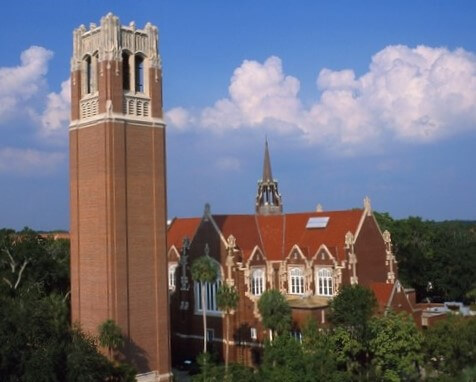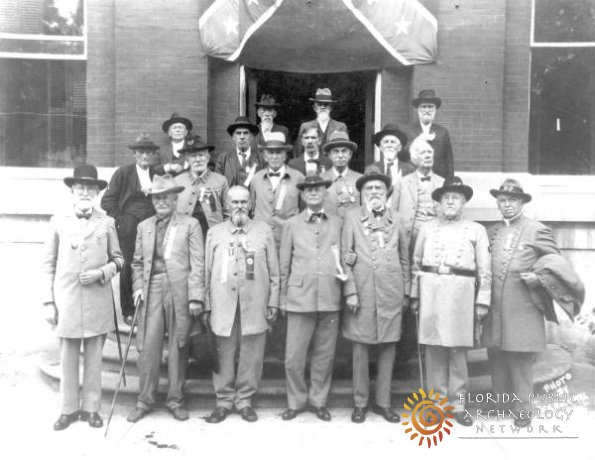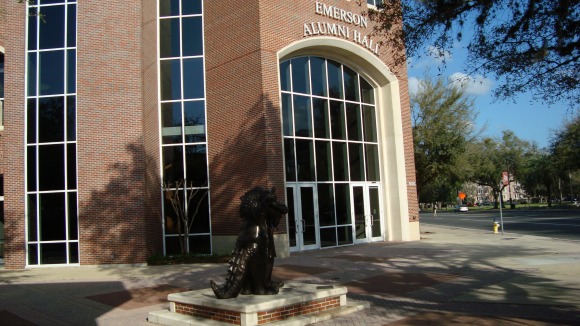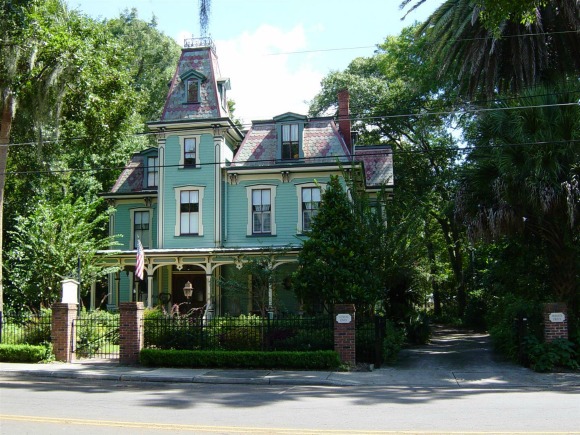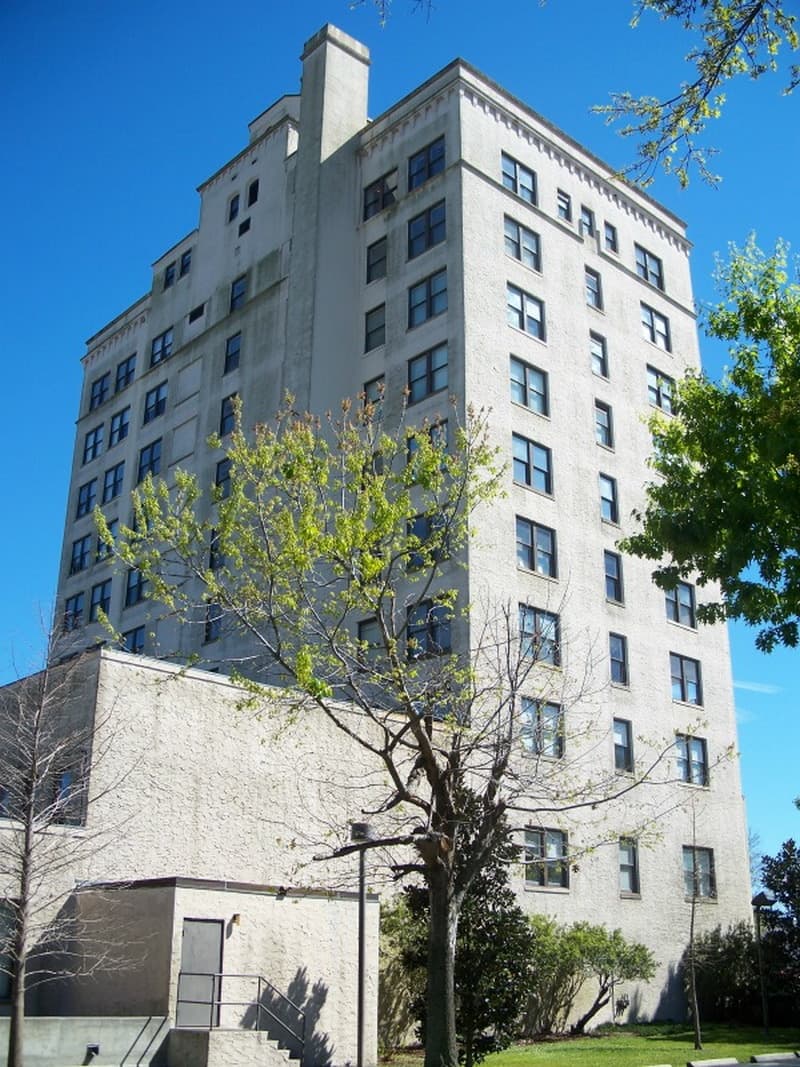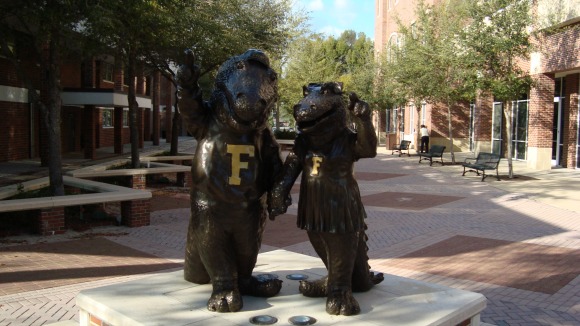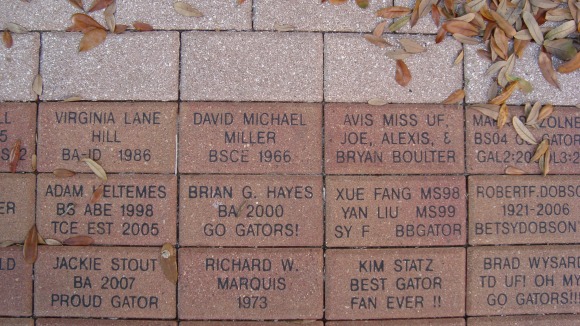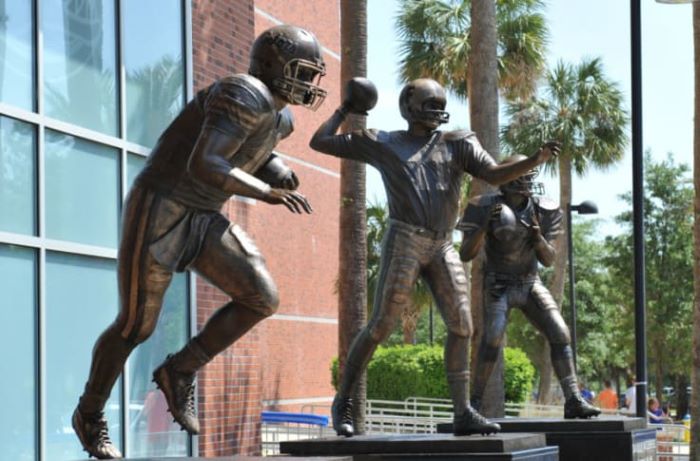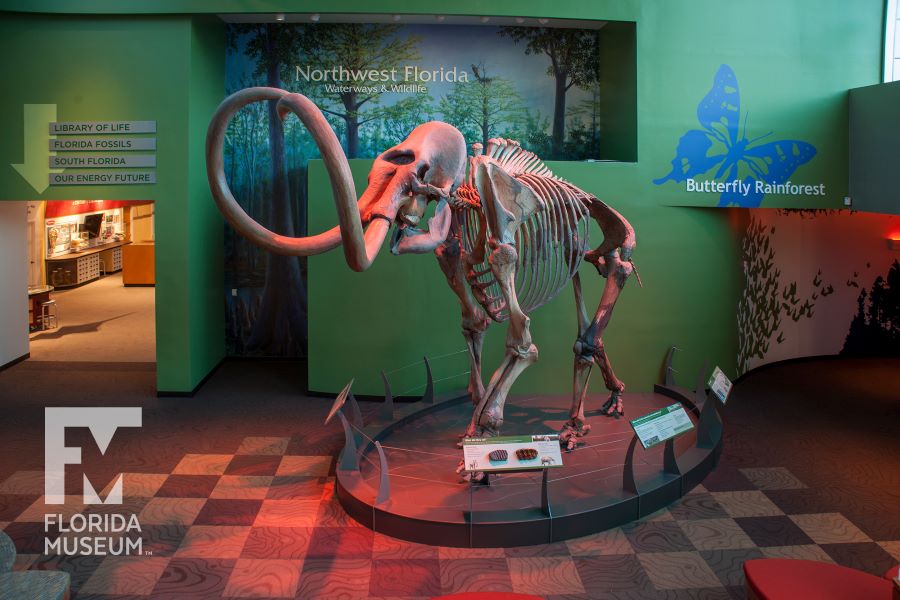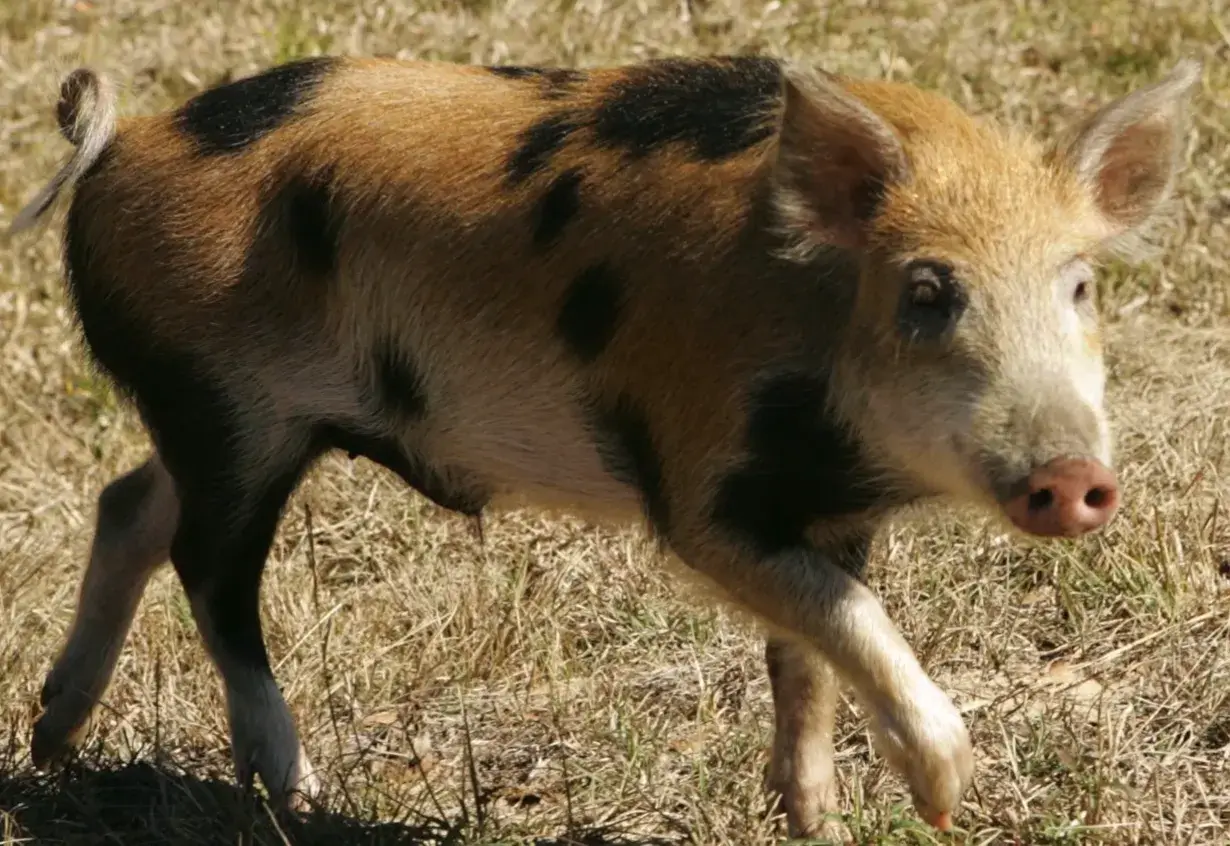- Home
- Florida Towns
- Gainesville
GAINESVILLE, FLORIDA
By Mike Miller Updated November 27, 2024
Gainesville, Florida Things To Do, Lodging, Dining, & Real Estate At End Of Article
Gainesville, Florida is located in North Central Florida and has a population of about 141,000.
The city is on the major north-south highways I-75 and US-441 and is the home of the University of Florida.
HISTORY OF GAINESVILLE, FLORIDA
The area around Gainesville was at one time a Timucuan Indian village.
The Timucuans were an indigenous tribe that occupied Florida long before the Seminoles came down from Georgia and the Carolinas.
Back in 1817, when Spain owned Florida, the King of Spain gave a massive land grant in the area to Don Fernando de la Maza Arredondo.
After Florida became part of the United States, planters and farmers moved into what is now Alachua County and helped Florida become a state in 1845.
The area near the future Gainesville was known as Hogtown, the name of a nearby creek.
The first county seat was Newnansville. When David Levy Yulee built his railroad from Fernandina Beach to Cedar Key, the tracks bypassed Newnansville.
The citizens then created a new town on the railroad named Gainesville.
It was named after General Edmund Gaines, a veteran of the Seminole Wars, and became the county seat.
Florida was one of the Confederate States of America and the Civil War slowed growth in Gainesville. There were even a couple of small skirmishes between Confederate and Union troops.
After the Civil War, Gainesville began to flourish as a center for cotton processing and shipping.
Citrus and vegetables also became major economic forces, followed later by phosphate and lumber operations.
But the biggest boon to Gainesville was when the University of Florida decided to move to town.
GAINESVILLE, FLORIDA TODAY
The town's future was assured when the University of Florida located there in 1906.
Gainesville history is closely tied to University of Florida history.
Gainesville is a comfortable family town with the rolling terrain and large oak trees typical of north central Florida.
Like many smaller college towns, the population is seasonal. Summers are very quiet in Gainesville when most of the students are gone. The major employer in Gainesville is the University of Florida.
The city has been recognized in several guides as having a low cost of living, and having a higher quality of life.
ALL ROADS LEAD TO GAINESVILLE FLORIDA
Much of Gainesville's commercial activity is centered around the University as well as the main highways that radiate out from Gainesville like the spokes on a wheel.
These include University Avenue which branches of into State Road 26 and becomes S.E. Hawthorne Road; US-441, known in Gainesville as 13th Street; Archer Road; Newberry Road; Waldo Road; and Williston Road.
Each of these roads leads to the Old Florida small town for which it is named: Archer, Newberry, Waldo, and Williston.
GAINESVILLE FLORIDA INNOVATION DISTRICT
Much of Gainesville's business life is centered along West University Avenue in what is called the Innovation District.
It is located one block east of the University of Florida campus, and two blocks west of what is called Downtown Gainesville. This district has many offices, restaurants, shops.
HISTORIC DOWNTOWN GAINESVILLE FLORIDA
The heart of downtown Gainesville is centered around West University Avenue and Main Street a couple of blocks west of the Innovation District.
It has become a trendy neighborhood centered around its town square.
Music lovers will recognize the town square's moniker, Bo Diddley Plaza in honor of one of Gainesville's favorite musicians.
The square often has live music concerts and other events. Bo Diddley's gravesite is in nearby Bronson.
There has been a large effort to restore many of the old buildings, and there are many historic buildings registered in the National Register of Historic Places in the University area and throughout the surrounding city of Gainesville neighborhoods.
This is where the Hippodrome Theatre is located. The square features a Wednesday farmer's market, several restaurants and bed and breakfast inns.
Another interesting building here is the Thomas Center, which used to be a hotel.
The Hippodrome serves Gainesville today as the venue for their community and movie theater. It was Gainesville's post office in its former life.
Near the theater is the Matheson History Museum, dedicated to preserving and sharing the history of the town and the area.
GAINESVILLE GEORGIA SEAGLE BUILDING
A tall historic building has long dominated the area between the Innovation and Downtown districts on the north side of University Avenue.
This was known to old Gators of my vintage as the Georgia Seagle Building or just plain Seagle Building.
It began its life in the "Roaring Twenties" as the Hotel Kelly. The hotel went broke even before it opened when the state and local economies crashed.
The old hotel was rescued in the 1930s by a Jacksonville woman named Georgia Seagle. She along with the University of Florida and some federal grant money finished the building.
Ms. Seagle then named the building after her brother, John F. Seagle.
The building has been renovated and repurposed over the years. At one time it became the Dixie Hotel.
Today the first 6 floors are commercial space; the remaining 5 floors are residential units, and the top floor is a single unit.
The building was added to the National Register of Historic Places in 1982 as the John F. Seagle Building, with the mention of its historic use as the Hotel Kelley and the Dixie Hotel.
THE UNIVERSITY OF FLORIDA CAMPUS
Residents of Gainesville and visitors love the variety of things to do and see on the campus of the University of Florida.
Starting in September, the school year is a beehive of activity until the following June.
In addition to having an excellent academic reputation, the Gators also have nationally ranked football, basketball and baseball teams.
Not that I am biased, but I do have a brick on the Emerson Hall Alumni courtyard. My brick is very close to the statues of Albert and Alberta.
These friendly gators are the team mascots of the University of Florida athletic teams. Albert came on the scene first, followed some years later by Alberta.
It is not clear whether they are man and wife, significant others, or just plain UF classmates.
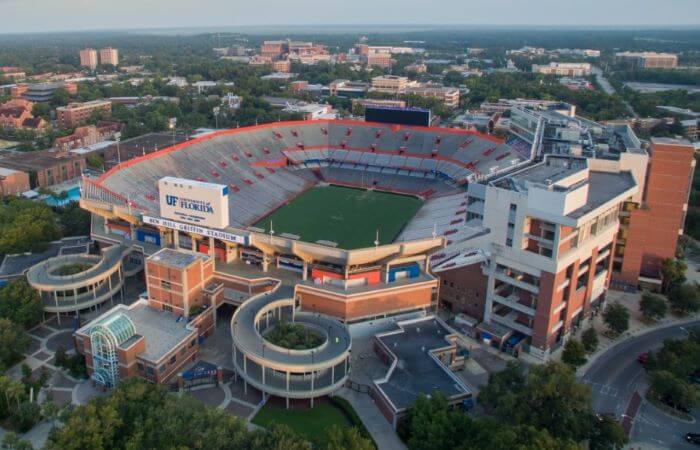 Steve Spurrier-Florida Field at Ben Hill Griffin Stadium
Steve Spurrier-Florida Field at Ben Hill Griffin StadiumPablo Corredor, CC BY-SA 4.0
There are so many things to do and see on the campus they can't all be listed here.
The dominant feature of the campus is on the south side of West University Avenue: the football stadium. It was known to old Gators like me as "Florida Field."
Things change and it is now officially known as Steve Spurrier-Florida Field at Ben Hill Griffin Stadium.
Gator football fans and their opponents simply call it "The Swamp", a name created by the legendary Steve Spurrier.
It is the largest football stadium in Florida and the 12th largest in American college football. It has a seating capacity of 88,548, but sometimes they let a few more pack in.
Bronze statues of three Gator Heisman Trophy winners are displayed in front of the stadium: Steve Spurrier, Danny Wuerffel, and Tim Tebow. They were all quarterbacks.
Another must see attraction on the campus is the Florida Museum of Natural History. It is one of the best museums of its kind in the world.
Kids love the giant prehistoric mammoth skeleton, a hands-on discovery zone, the bat cave, and the butterfly rainforest.
Another fun family spot is the Cade Museum for Creativity and Invention. This unique place showcases inventions and their histories, offers many educational programs and encourages innovation.
It is named for Dr. James Robert Cade, who gave a large donation to get the vision off the ground.
Dr. Cade was a renal specialist and professor at University of Florida, and was the inventor of the well known sports drink Gatorade.
SOME OTHER NEAT THINGS TO SEE IN GAINESVILLE
Northeast Gainesville became an upper class neighborhood after the turn of the 19th century in the areas known as the Duck Pond and the Highlands.
In the early years of the twentieth century, four presidents of the University of Florida lived in these neighborhoods.
Gainesville residents have done a good job of restoring and preserving these neighborhoods.
Gainesville's location in north central Florida makes it an excellent starting point for many interesting day trips and scenic drives.
Gainesville and the surrounding areas have plenty of nature to enjoy too, with 7 Florida State Parks along with nature centers and wild spaces to enjoy hiking, bird watching and water activities.
Some favorite places to see are Paynes Prairie Preserve State Park, and the historic villages of Micanopy, McIntosh, and Cross Creek, the home of writer Marjorie Kinnan Rawlings.
Sweetwater Wetlands Park is a 125 acre wetlands area that is home to a variety of plants, animals and birds, including Florida Cracker horses. Open during the day only, it offers walking paths and wildlife viewing.
Plant enthusiasts will enjoy the Kanapaha Botanical Gardens, which has a large bamboo collection in addition to the largest herb garden in the Southeast, in addition to the many flower varieties.
They have a picnic area, and each spring they have a large Spring Garden Festival that attracts thousands.
Here is a link to hundreds of things to do and see within 100 miles of Gainesville. GAINESVILLE FLORIDA DAY TRIPS
OUR FAVORITE GAINESVILLE RESTAURANT
We love this new restaurant in Gainesville, Spurrier's Gridiron Grille. It is named for former Gator great player and coach, Steve Spurrier. It has great food, ambience, and sports memorabilia. The Head Ball Coach himself shows up frequently.
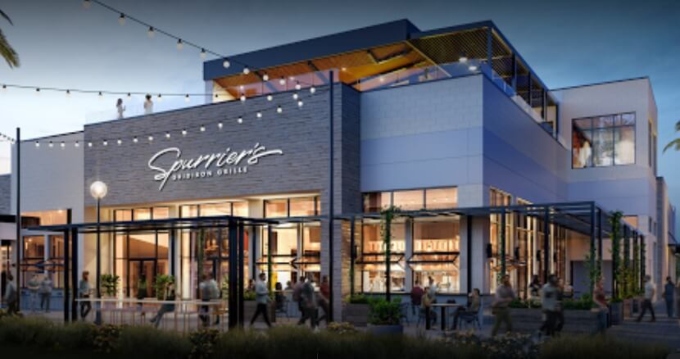
THINGS TO DO IN GAINESVILLE, FLORIDA
Cade Museum for Creativity and Invention
811 S Main Street, Gainesville, FL 32601 | (352) 371-8001
I discussed this earlier on this page.
Florida Museum of Natural History
3215 Hull Rd, Gainesville, FL 32611 | (352) 846-2000
I described this earlier on this page. Step into a world of fluttering beauty at the Butterfly Rainforest, where hundreds of butterflies from around the globe fly freely in a lush, tropical garden.
This living exhibit provides an up-close experience with these delicate creatures, making it a favorite among visitors. It's a place of tranquility and beauty, perfect for nature lovers and those seeking a serene escape.
Paynes Prairie Preserve State Park
100 Savannah Blvd, Micanopy, FL 32667 | (352) 466-3397
Just a short drive away in Micanopy, Paynes Prairie Preserve State Park offers a unique outdoor experience with its diverse ecosystems and rich history.
The park's trails, including the La Chua Trail, provide opportunities to see wild horses, bison, and a variety of bird species. It’s a must-visit for nature lovers looking to explore one of Florida's most significant natural landmarks.
Sweetwater Wetlands Park
325 SW Williston Rd, Gainesville, FL 32601 | (352) 554-5871
I described this park earlier on the page.
Depot Park
874 SE 4th St, Gainesville, FL 32601 | (352) 393-8510
Depot Park is Gainesville's premier community space, offering something for everyone. With a scenic pond, children's play area, and walking trails, it's a perfect spot for a family outing or a leisurely afternoon.
The park also hosts events and concerts, making it a lively center of activity in downtown Gainesville.
Kanapaha Botanical Gardens
Summer House, 4700 SW 58th Dr, Gainesville, FL 32608 | (352) 372-4981
I described the Gardens earlier on this page. Here is their contact info.
Historic Haile Homestead
8500 SW Archer Road, Gainesville, FL 32608 | (352) 336-9096
Discover the rich history of Gainesville at the Historic Haile Homestead. Built in 1856, this plantation house is renowned for its "Talking Walls," where the Haile family and their guests wrote more than 12,500 words on the walls of their home.
The homestead offers a unique glimpse into the lives of those who lived there, making it a fascinating visit for history buffs.
Samuel P. Harn Museum of Art
3259 Hull Road, Gainesville, FL 32611 | (352) 392-9826
Art enthusiasts will enjoy a visit to the Samuel P. Harn Museum of Art, home to a vast collection of international art. It houses exhibits ranging from African and Asian art to contemporary and modern pieces.
The museum offers a cultural journey through the visual arts. It’s a great place to find inspiration and appreciation for the creative expressions of diverse cultures.
Santa Fe College Teaching Zoo
3000 NW 83rd Street Building Z, Gainesville, FL 32606 | (352) 395-5633
Explore the unique Santa Fe College Teaching Zoo, a 10-acre facility managed by zoo animal technology students. This zoo provides an intimate look at a variety of species, with an emphasis on education and conservation.
It’s our favorite destination for animal lovers and those interested in learning more about wildlife conservation efforts.
ALL ABOUT GAINESVILLE, FLORIDA
GAINESVILLE, FLORIDA INTERACTIVE GOOGLE MAP
Our Facebook page has more than 130,800 followers who love off the beaten path Florida: towns, tourist attractions, maps, lodging, food, festivals, scenic road trips, day trips, history, culture, nostalgia, and more.
By Mike Miller, Copyright 2009-2025
Florida-Back-Roads-Travel.com
Florida Back Roads Travel is not affiliated with or endorsed by Backroads, a California-based tour operator which arranges and conducts travel programs throughout the world.
